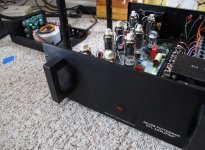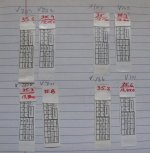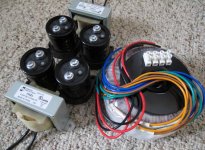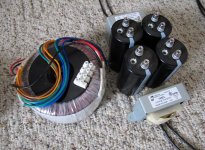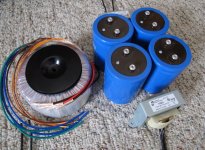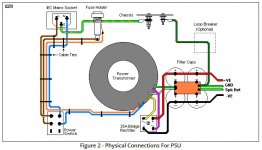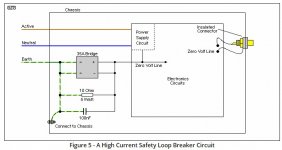Hi Ozark
Yes the benefit of the double die ECW series is quite appealing as it solves possible matching issue for a pair. ECW20N20 and 20P20 are rated 250W and 200V max (before derating) so quite powerful for the usual 250-300ma output bias current of these Hafler designs.
Unfortunately I have not used the Hitachi since a long time and in a different design than with the Exicon or even Alfet (before they stopped production). I could not notice differences in sound between Alfet and Exicon. It is difficult to appreciate difference in sound of the same data sheet component if everything else is not the same. I can do this exercice for different transistor types with my variation of USSA3 and 5 designs using different transistors in the same topology though. The bias current used for each device type is important too. I find these variations with the same amplifier topology very informative I can tell you .
.
Good luck with your build.
Fab
Yes the benefit of the double die ECW series is quite appealing as it solves possible matching issue for a pair. ECW20N20 and 20P20 are rated 250W and 200V max (before derating) so quite powerful for the usual 250-300ma output bias current of these Hafler designs.
Unfortunately I have not used the Hitachi since a long time and in a different design than with the Exicon or even Alfet (before they stopped production). I could not notice differences in sound between Alfet and Exicon. It is difficult to appreciate difference in sound of the same data sheet component if everything else is not the same. I can do this exercice for different transistor types with my variation of USSA3 and 5 designs using different transistors in the same topology though. The bias current used for each device type is important too. I find these variations with the same amplifier topology very informative I can tell you
Good luck with your build.
Fab
Last edited:
DH200 series (thinking outside of) the small box
People would "beat me up" and give me crap about using the DH 200 series bodies, but for scale of economy and ease (at points leading up to now) I felt my time was better spent modeling the various ideas, parts, builds and/or over multiple chassis. Spending 10 hours building a box, plus parts (as a course example) I could buy multiple DH chassis, which also lended to identical boxes and parts, with minor circuit variations. I could be much closer to my musical goals and have an exact understanding of what hierarchically makes a valid difference.
These amps are truly surpassing the $$$ Big Boy SS Boxes (which I sold off) by direct A/B comparisons.
At the time 2012-13, I traveled for a living... was always on the road and with a corporate salary, I bought a bunch of Haflers off eBay (I 'had more money' than time) However in 'retirement' after 2015, I now "have more time than money", so to speak... I finally had the ability and have just gotten around to tinkering more wildly with the resources on hand, furthering builds that I already owned. I don't want to sound snobby or foolish, not bragging and not apologizing. I am done buying $$$ Levinson and Audio Research gear.
I would much rather devote my time and monetary resources
to the high grade parts, to build that which we cannot buy...
"Dream amps" built on a budget... $2,000 = $10,000
The recent (past few years especially) I have been directly comparing to my Atma-Sphere and Futterman OTL amps [among the best amps, that I have ever heard, owned or lived with, for extended periods] These hyper Haflers, especially my P230 mono amps, have been the daily drivers and are so close, in ways “surpassing” these venerable vacuum tube designs. *I struggle saying, tubes have simply become a pain in the ***… Dual triode variability (matching) and “lower quality” tube of today, they are “no longer affordable”.
I am now motivated to build completely from scratch... absolutely confident the work (time and money) will be justified and worthwhile.
Image is of the P230 mono side by side the *classic* Futterman OTL-4 (with brand new, hand sorted, very tightly matched tubes, input to output) It does not get any better than this... My home made P230 amp is truly *that spectacular* in a side by side direct comparison... Most "inexperienced" listeners and audiophiles would not be able to hear the subtle differences.
People would "beat me up" and give me crap about using the DH 200 series bodies, but for scale of economy and ease (at points leading up to now) I felt my time was better spent modeling the various ideas, parts, builds and/or over multiple chassis. Spending 10 hours building a box, plus parts (as a course example) I could buy multiple DH chassis, which also lended to identical boxes and parts, with minor circuit variations. I could be much closer to my musical goals and have an exact understanding of what hierarchically makes a valid difference.
These amps are truly surpassing the $$$ Big Boy SS Boxes (which I sold off) by direct A/B comparisons.
At the time 2012-13, I traveled for a living... was always on the road and with a corporate salary, I bought a bunch of Haflers off eBay (I 'had more money' than time) However in 'retirement' after 2015, I now "have more time than money", so to speak... I finally had the ability and have just gotten around to tinkering more wildly with the resources on hand, furthering builds that I already owned. I don't want to sound snobby or foolish, not bragging and not apologizing. I am done buying $$$ Levinson and Audio Research gear.
I would much rather devote my time and monetary resources
to the high grade parts, to build that which we cannot buy...
"Dream amps" built on a budget... $2,000 = $10,000
The recent (past few years especially) I have been directly comparing to my Atma-Sphere and Futterman OTL amps [among the best amps, that I have ever heard, owned or lived with, for extended periods] These hyper Haflers, especially my P230 mono amps, have been the daily drivers and are so close, in ways “surpassing” these venerable vacuum tube designs. *I struggle saying, tubes have simply become a pain in the ***… Dual triode variability (matching) and “lower quality” tube of today, they are “no longer affordable”.
I am now motivated to build completely from scratch... absolutely confident the work (time and money) will be justified and worthwhile.
Image is of the P230 mono side by side the *classic* Futterman OTL-4 (with brand new, hand sorted, very tightly matched tubes, input to output) It does not get any better than this... My home made P230 amp is truly *that spectacular* in a side by side direct comparison... Most "inexperienced" listeners and audiophiles would not be able to hear the subtle differences.
Attachments
Thanks Fab!
I greatly appreciate the perspective and input... And reacquainting me to the Goldman Wiki thread. I poured over the posts there... BTW, I have a total of 60 assorted Exicons in my cart... I am still trying to make up my mind. I am apt *to over buy* to have the grouping from the same production lots... 80 : 20 TO264/TO247 to TO3, mostly TO264.
Thanks to others too (for collective input) MUCH appreciated!
Hi Ozark
Yes the benefit of the double die ECW series is quite appealing as it solves possible matching issue for a pair. ECW20N20 and 20P20 are rated 250W and 200V max (before derating) so quite powerful for the usual 250-300ma output bias current of these Hafler designs.
Unfortunately I have not used the Hitachi since a long time and in a different design than with the Exicon or even Alfet (before they stopped production). I could not notice differences in sound between Alfet and Exicon. It is difficult to appreciate difference in sound of the same data sheet component if everything else is not the same. I can do this exercice for different transistor types with my variation of USSA3 and 5 designs using different transistors in the same topology though. The bias current used for each device type is important too. I find these variations with the same amplifier topology very informative I can tell you.
Good luck with your build.
Fab
I greatly appreciate the perspective and input... And reacquainting me to the Goldman Wiki thread. I poured over the posts there... BTW, I have a total of 60 assorted Exicons in my cart... I am still trying to make up my mind. I am apt *to over buy* to have the grouping from the same production lots... 80 : 20 TO264/TO247 to TO3, mostly TO264.
Thanks to others too (for collective input) MUCH appreciated!
Modeling CLC power supply options for P230 mono
I am still gathering parts to approach the (long held) ideas of nth degreeing the (too often overlooked) heart of the amp... it is vital to update power supplies, even ones like mine... that are already ~ w a y ~ past the stock power supply so common in many vintage Hafler amps...
Cheap, old, original, vintage caps are like worn out springs with no bounce.
They should be replaced, ~ and bypassed ~ before doing .any. PCB work.
My short rant... it is cheap and easy work... capacitors have come
such a long way in the past 40 years... LOLS.
I (have on hand) plan on using a pair of 625va / 45v and 1000va / 45v, I want to hear the difference (if any) with effectively doubling and tripling the power transformers (over stock) and I will also try the CLC networks for scale... Every single improvement that I have made in the power supply has advanced the musical threshold ...greatly... I have to try it...
The very best I have heard are the $$$ expensive Mundorf MLytic HC (loco) caps, which have redefined the level of performance beyond the Nichicon LNR / LNT, Nippon Chemi-Con and even (discontinued) $$$ Jensen 4-pole caps, all of which that I have lived with for ~many years.
I remember experiencing the ($16K) Cello Encore amps back in the early 90's driving my Quad ESL-63s... It was said to have used a Pi filter network in the P/S. It was so smooth like butter... unlike any SS amps of the day... when compared to my Futterman OTL3s... very un-solid state like... it made a real lasting and lingering impression on me.
I am still gathering parts to approach the (long held) ideas of nth degreeing the (too often overlooked) heart of the amp... it is vital to update power supplies, even ones like mine... that are already ~ w a y ~ past the stock power supply so common in many vintage Hafler amps...
Cheap, old, original, vintage caps are like worn out springs with no bounce.
They should be replaced, ~ and bypassed ~ before doing .any. PCB work.
My short rant... it is cheap and easy work... capacitors have come
such a long way in the past 40 years... LOLS.
I (have on hand) plan on using a pair of 625va / 45v and 1000va / 45v, I want to hear the difference (if any) with effectively doubling and tripling the power transformers (over stock) and I will also try the CLC networks for scale... Every single improvement that I have made in the power supply has advanced the musical threshold ...greatly... I have to try it...
The very best I have heard are the $$$ expensive Mundorf MLytic HC (loco) caps, which have redefined the level of performance beyond the Nichicon LNR / LNT, Nippon Chemi-Con and even (discontinued) $$$ Jensen 4-pole caps, all of which that I have lived with for ~many years.
I remember experiencing the ($16K) Cello Encore amps back in the early 90's driving my Quad ESL-63s... It was said to have used a Pi filter network in the P/S. It was so smooth like butter... unlike any SS amps of the day... when compared to my Futterman OTL3s... very un-solid state like... it made a real lasting and lingering impression on me.
Attachments
Exicon Mosfets
EXICON MOSFET article
Above is a link to a page documenting a rebuild process for a DH-500 (so not strictly on-topic), but using similar replacement semiconductors as the DH-200, and similar upgrade suggestions as outlined in this thread.
Six.
EXICON MOSFET article
Above is a link to a page documenting a rebuild process for a DH-500 (so not strictly on-topic), but using similar replacement semiconductors as the DH-200, and similar upgrade suggestions as outlined in this thread.
Six.
Good article Sixto!
I have seen that persons, posts, page or article(s).
*not sure when, where or how... LOLS.
A good read, I can readily relate to their works
and the process of evolving builds. I was very glad
to see their address of the power supply, wiring
and how it influenced the overall sound.
Too few do this sort of work.
Sadly neglected...
Thanks for sharing, it applies irrespective of
the chassis or amplifier, great information.
I have seen that persons, posts, page or article(s).
*not sure when, where or how... LOLS.
A good read, I can readily relate to their works
and the process of evolving builds. I was very glad
to see their address of the power supply, wiring
and how it influenced the overall sound.
Too few do this sort of work.
Sadly neglected...
Thanks for sharing, it applies irrespective of
the chassis or amplifier, great information.
Last edited:
I am still gathering parts for my DH200C amp. This might take months, so I keep myself motivated by reading earlier posts like the one quoted below... I would like to make my build safer by adding a 3-pronged IEC connector (with fuse) to the chassis. And wanted to ask if there are any considerations I'm missing to establish a solid grounding scheme...Following Rod Elliot's diagrams attached.
1) Run ground prong from IEC plug to Chassis directly.
3) Add a Safety Loop Breaker from Chassis Earth to all other ground connections in Power Supply 0-volt point. (between caps + and -)
3) Run new wires from Power Supply board (Musical Concepts PS-200A) to new DH200C boards.
4) Replace all input and speaker connections with new copper units (isolated from chassis).
5) Are there additional steps required to segregate signal and chassis ground?
Thanks! - Six.
1) Run ground prong from IEC plug to Chassis directly.
3) Add a Safety Loop Breaker from Chassis Earth to all other ground connections in Power Supply 0-volt point. (between caps + and -)
3) Run new wires from Power Supply board (Musical Concepts PS-200A) to new DH200C boards.
4) Replace all input and speaker connections with new copper units (isolated from chassis).
5) Are there additional steps required to segregate signal and chassis ground?
Thanks! - Six.
You have to stick to a selected grounding scheme. The Hafler as designed and constructed used the chassis as part of the grounding scheme. It thus mixed signal and chassis ground. Thus, unless you are going to completely rewire the amp, you have to keep the decoupling caps grounded to chassis.
What this means is that the typical position for the ground loop breaker is not going to work. You have to put it between the ground wire where it comes out of the AC wire, and the chassis ground. That may violate some legal requirements and may not be safe because if the ground loop goes open on a fault, then there is no safety ground AT ALL.
I guess the bottom line is, unless you are going through the trouble of rewiring the entire amp and carefully segregating signal and PS grounds from safety/chassis grounds, the ground loop breaker may not be a good thing to use. Instead, if you need to break a verified ground loop, use a high quality line input transformer like those from Jensen or Cinemag.
Attachments
Thank you for articulating the concept of changing the grounding scheme, Sixto.
I want to do that as well with my DH220 when I upgrade the power supply (new filter caps, rectifier, etc).
That previous post from Halauhula and the ESP diagrams are very helpful. Thanks for pulling all that together for everyone!
I want to do that as well with my DH220 when I upgrade the power supply (new filter caps, rectifier, etc).
That previous post from Halauhula and the ESP diagrams are very helpful. Thanks for pulling all that together for everyone!
Been out-of-the-loop on this for a time due to competing life events, but today I ordered the pcb’s plus fets ...
Is there a bom all setup to go for this at mouser?
Can’t wait to get started! The renewed amp will drive my Paradigm Studio 100 v5 speakers.
I am also looking for a good set of rear speaker binding posts for the amp, if anyone has part number suggestions.
Is there a bom all setup to go for this at mouser?
Can’t wait to get started! The renewed amp will drive my Paradigm Studio 100 v5 speakers.
I am also looking for a good set of rear speaker binding posts for the amp, if anyone has part number suggestions.
I really like using my Topping E30 DAC for volume attenuation. I only have 2 digital sources: Logitech Squeezebox and a Roku for TV. I definitely don’t need any more gain than the DH-220C and like keeping the signal chain simple.
I already have a class d project in mind for a warm-weather amp/second system and have a speaker project looming. Maybe tubes or class a solid state will be a future amp project.
I also use E30 into DH220...simple, effective. (I wish there was a version of E30 that could accept an HDMI input with ARC to avoid the separate volume remote)
Been out-of-the-loop on this for a time due to competing life events, but today I ordered the pcb’s plus fets ...
Is there a bom all setup to go for this at mouser?
Can’t wait to get started! The renewed amp will drive my Paradigm Studio 100 v5 speakers.
I am also looking for a good set of rear speaker binding posts for the amp, if anyone has part number suggestions.
Hi Peter,
Yes there is a Mouser BOM for the DH-220C. Rick can give you more details. I believe the BOM and other information is available in the cloud, to which you get access when you purchase the boards.
Cheers,
Bob
Btw where did you get these boards? Is there a site... a store?
They are available on eBay from Rick Savas. Search on DH-220C.
Cheers,
Bob
I am also looking for a good set of rear speaker binding posts for the amp, if anyone has part number suggestions.
Here is what I bought... since they are single post, the spacing is more flexible...(though I may still need to enlarge the existing holes) 4Pcs Rhodium Plated Alloy HIFI Amplifier Speaker Terminal Binding Post Socket US | eBay
- Home
- Amplifiers
- Solid State
- Hafler DH-200/220 Mods
